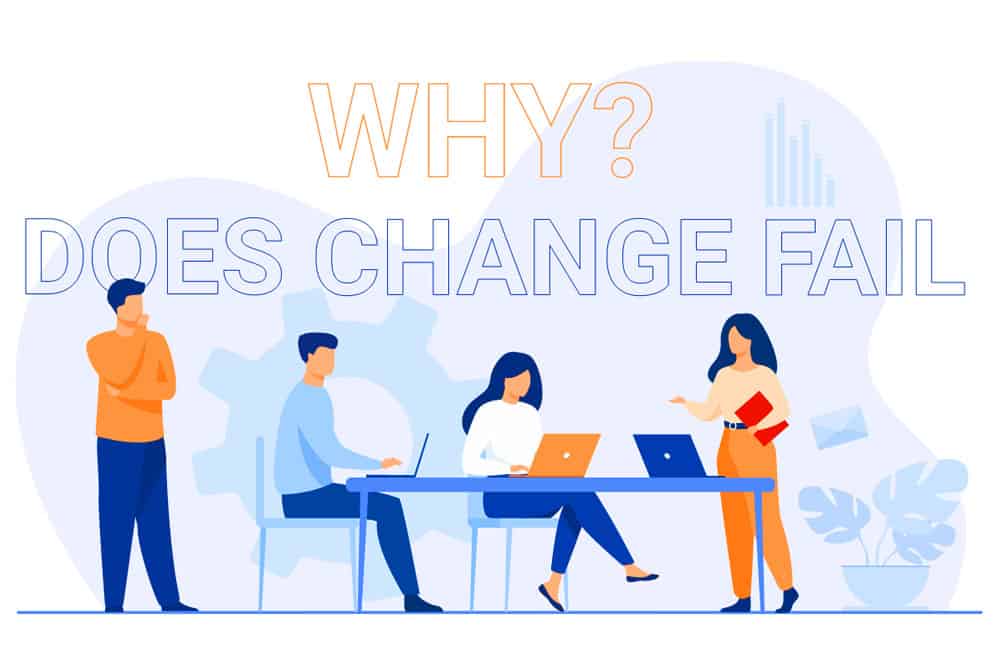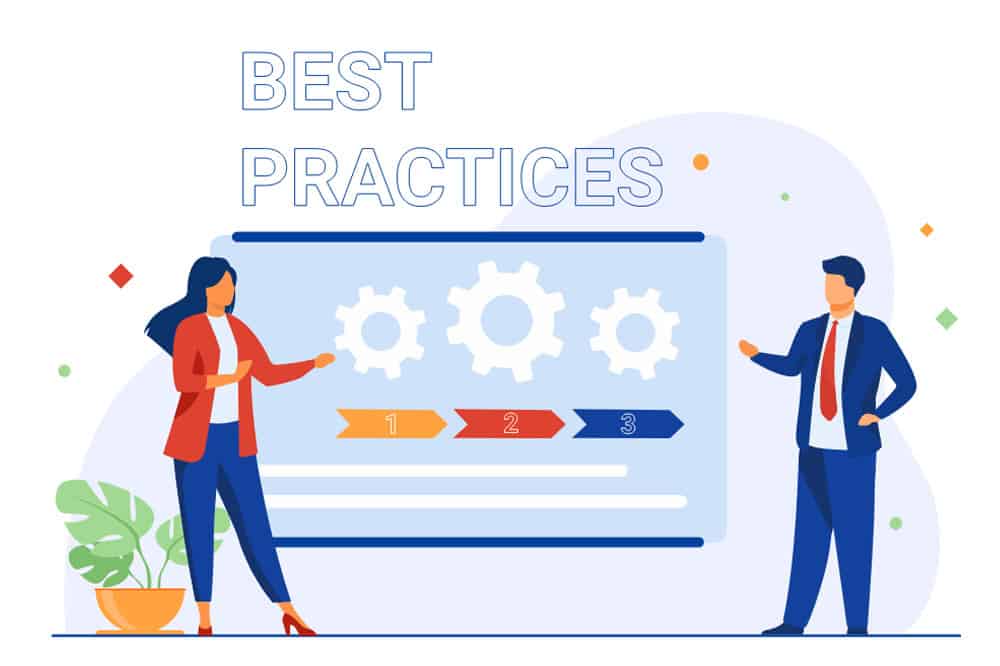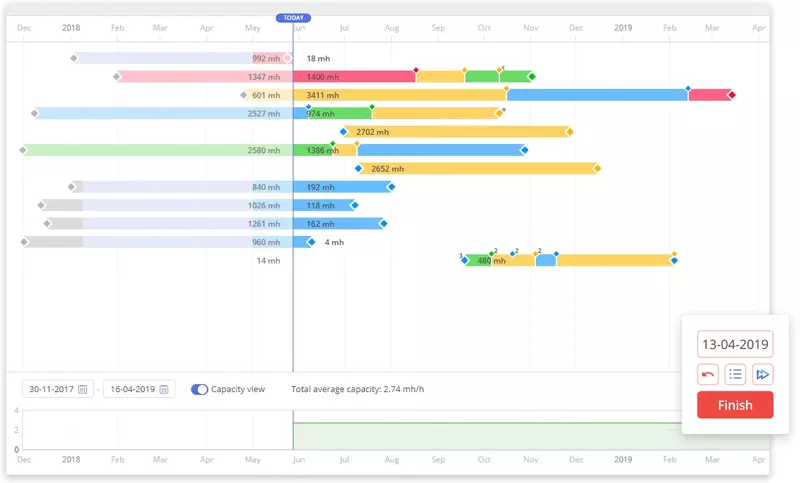According to McKinsey, more than 70% of change initiatives fail. Disappointing, isn’t it? However, change is a must for every organization that wants to succeed, especially in the post-pandemic world, so it’s essential to embrace it right there and then.
Managing change is closely related to people, which makes it rather difficult to implement. For example, you may be 100% sure that your organization needs change, but if your employees resist it, there’s much chance of being among the above-mentioned 70%. Therefore, it’s extremely important to know the “recipe for success” in terms of change introduction and management.
Let’s analyze why change initiatives become fruitless, and what practices will help you manage change efficiently.
The Role of Change Management
Change management is often considered in relation to digital transformation that typically involves the adoption of new processes, changes in the existing ones, and sometimes substitution of old processes with the new ones. In other words, digital transformation involves large-scale change. The pandemic has made it clear that the need for change is now more urgent than ever before, and business leaders as well as employees have to adapt to the “new normal”. To make this adaptation successful and smooth, change has to be managed. What does it mean?
Change management can be defined as a comprehensive approach taken in an organization to move from the current to a future desirable state using coordinated and structured efforts in collaboration with stakeholders [1]. This approach involves the application of processes, tools, and techniques that are required to administer the human side of change. Digital transformation initiatives have more chances for success when the staff are enthusiastic about the changes, and this is where change management comes in: it can motivate employees to support them and actively participate in new activities.
What are the other goals of change management?
Change Management Goals
Basically, the primary goal of change management is to successfully implement new processes, products and business strategies while minimizing negative outcomes [2]. It can be achieved as a result of reaching a number of smaller objectives:
- developing innovation culture,
- increasing employees’ motivation,
- maintaining momentum.
Therefore, change management aims to ensure smooth transition of an organization to the desired state in the future.
Despite significant efforts, a great number of change initiatives fail, as we mentioned earlier. What are the reasons, and what obstacles are there on the way to successful transformation? Let’s review them in the next section.
Why Do Change Efforts Become Unsuccessful?

- A lack of understanding the idea behind change implementation.
This leads to insufficient support of these efforts by both senior management and employees. Without their support, change cannot be implemented successfully.
- Change is regarded as a risk.
Both C-suite executives and employees may have doubts about implementing change. They may have fear of losing their jobs, changes in their current responsibilities or cultural alternations, and consequently regard change as a risk.
Read more: Project Risk Management: Importance, Challenging Issues, Recommendations
- Ignoring resistance to change.
Resistance is a natural human response to change that should be taken into account by those who initiate it. It can be overt or implicit, but both forms shouldn’t be ignored.
- Too intensive change implementation.
If an organization has too many change initiatives and related projects as well as no prioritization mechanism to navigate this flow, its employees will soon become exhausted with this intensity. Being tired and overworked, they won’t be able to deliver their tasks and projects successfully [3].
- Insufficient focus on culture change.
Organizational transformation is impossible without changing the culture existing in a company. It refers to a set of goals, roles, processes, values, communication practices, attitudes and assumptions [4].
- Lack of flexibility in planning.
In the present-day “VUCA world”, flexibility and agility are a must. So, when developing a change implementation plan, be ready to adjust it to changing internal or external conditions.
- Insufficient attention to employees’ personal and professional development.
When an organization undergoes changes, its employees require new hard and soft skills to be able to perform their duties successfully under these new conditions.
How to overcome these obstacles and make change management effective for your organization? The following recommendations will help.
Change Management Best Practices

Define your end goal clearly
It’s important to lay the foundation for change:
- Define the current state of an organization to know what exactly requires change and what doesn’t.
- Create a business case for change: why the current state requires transformation and how it will affect customers, employees, and shareholders.
- Finally, determine the end goal of your change initiatives and establish timelines.
Adopt a change management framework
A change management framework offers a systematic approach to managing change. Being combined with other change management best practices, these frameworks increase chances for successful change implementation. You can choose from the most popular frameworks: McKinsey 7-S Framework, ADKAR Model, Kotter 8-Step Process for Leading Change, Lewin’s Change Model, and Satir Change Management Model.
Create a team of change agents
Change cannot be implemented solely by senior executives or employees. Instead, these tasks should be assigned to the team of change agents who have necessary skills and mindset and who will motivate and support the rest of an organization’s members.
Take care of your people to overcome their resistance
Firstly, communicate with your employees to facilitate acceptance of change by employees:
- explain the objectives, the vision, the mission, the context, and the need for change efforts,
- try to understand their concerns: use surveys, various feedback channels, or direct communication if possible,
- communicate regularly: repeating the idea of change will allow people to get used to it more quickly.
Secondly, provide training for employees. Apart from acquiring new skills and behaviors, it will psychologically prepare them for work in a changed organization and reduce their resistance.
Prioritize change initiatives
Too many initiatives drain valuable resources and leadership attention. With this in mind, every change initiative, either new or the existing one, should be thoroughly analyzed regarding its value, feasibility, and related risks [5].
Change initiatives can be implemented as projects, so change management often goes with project management. What are the relations between them, and how does project management contribute to effective change management?
Change Management vs. Project Management
First of all, let’s consider change management vs. project management and the main differences between them. Take a look at the table below [8].
Despite that they differ from each other, they work together in the following ways:
- Collaboration of change management and project management makes it possible to implement transformations successfully: they are critical components of this endeavor that touch upon people and technical sides of change [6].
- Also, they can be regarded as complementary disciplines that have a common objective: being integrated in a certain initiative (or a project), they work together to achieve the desired outcomes of organizational change.
- Project management provides the structure, processes and tools to make the technical side of change happen, while change management provides the same for the people side of change [7].
At the same time, change management is no less important in project management as long as projects aim to change things [8].
When a change initiative is implemented as a project, utilization of project management software can streamline its workflow and increase the chances for success. In the next subsection, we’ll analyze PM tools’ contribution to successful management of the “technical” part of change management.
PM software solutions: Improve the project management side of change
As long as change is often implemented through multiple projects running simultaneously, it poses additional challenges: resource conflicts, overlapping deadlines, dependencies between projects, and other issues stemming from them. That’s why it’s critically important to leverage the tool that helps to cope with these issues and keep control of all the project and resource management processes. Let’s look into how these functions work through the example of Epicflow, a multi-project resource management tool.
What is special about Epicflow is that it has been designed by the experts with about 20 years’ experience in project management who have developed a scientific approach to solving project/resource managers’ pain points. Also, the idea behind Epicflow is to resolve challenges of a multi-project environment. So, let’s take a closer look.
Get a bird’s eye view of all your projects
It’s critical to keep track of every single project and the whole multi-project environment. In Epicflow, you can do this with the following features.
- Bubble Graph, which is an improved version of Fever Chart, makes it possible to monitor the workflows regarding time and budget constraints. It shows the structure and size of a project, the amount of remaining work/budget, and possible threats to the project’s success.
- Pipeline presents the list of all the projects running in a company, both active and inactive. They are sorted according to their priorities, and projects that require most of management attention appear on the top. When some changes occur, the priorities are automatically reset. You can also check the most constrained milestones and find out what causes bottlenecks.
Read more: Bubble Graph: Critical Chain Fever Chart Re-Imagined
With these two features you are always in the know as to the state of your multi-project environment; you can quickly and easily spot what provokes problems in the workflow and take necessary actions to get this project back on track.
Reduce uncertainty by making informed decisions
Uncertainty is an unavoidable part of both change and project management, which comes from a lack of necessary information. One of the ways to cope with it is to be prepared for different variants of possible outcomes. Epicflow offers the following opportunities to take a look into the future.
- Predict potential bottlenecks and try various scenarios with What-If Analysis. Change various parameters (move milestones, add or remove projects, try several variants of resource allocation, etc.), see how it will affect the final outcome, and come up with the most reasonable decision.

- Forecast resource bottlenecks with the Future Load Graph. Similarly to What-If Analysis, it shows your employees’ workload in the future depending on their current tasks. There are two important things here. First, you can prevent employees from overload that can cause problems to the whole project or even several of them. Secondly, you can forecast future resource shortages and take necessary measures to prevent them.
There are some more ways to cope with uncertainty.
Read more: Fighting Uncertainty in Project Management: Arm Yourself with the Right Tool
Utilize your resources with maximum efficiency
Resource management is an extremely important prerequisite of successful project delivery. With Epicflow’s Competence Management, you can keep record of team members’ competences, their levels, availability, and capacity. Therefore, it becomes much easier to allocate the right resources to project tasks. What is more, Epicflow can find and suggest a perfectly matching employee for a task. Finally, with Competence Management you can keep track of globally distributed employees’ skills and put an efficient team together.
Increase your team’s productivity
Let’s review two features that serve this purpose:
- Task List is every team member’s to-do list where the tasks are sorted according to their priorities. Working on the most important tasks and completing them asap contributes to employees’ efficiency (as they don’t procrastinate and avoid bad multitasking) and better overall outcomes.
- Historical Load Graph makes it possible to trace back the team’s historical output. You can use this information when planning their load in the future and set realistic expectations regarding their capabilities, which in turn will prevent them from being under- or overloaded.
Thus, Epicflow’s functions touch upon different sides of the project management process. However, its capabilities aren’t limited only to these features.
Contact us if you’d like to make Epicflow your assistant on the way to successful change management.
References
- What is change management and organizational change? Retrieved from https://www.apm.org.uk/resources/what-is-project-management/what-is-change-management/
- Managing organizational change. Retrieved from https://www.shrm.org/resourcesandtools/tools-and-samples/toolkits/pages/managingorganizationalchange.aspx
- Stise, Robert. Avoid these 5 change management obstacles. Retrieved from https://blog.prosci.com/avoid-these-change-management-obstacles
- Denning, Steve. (2011). How do you change an organizational culture? Retrieved from https://www.forbes.com/sites/stevedenning/2011/07/23/how-do-you-change-an-organizational-culture/?sh=58aa610839dc
- Johnston, A., Lefort, F., & Tesvic, J. (2017). Secrets of successful change implementation. Retrieved from https://www.mckinsey.com/business-functions/operations/our-insights/secrets-of-successful-change-implementation
- Creasey, Tim. Change management and project management: A side-by-side comparison. Retrieved from https://blog.prosci.com/change-management-and-project-management-comparison
- Integrating change management and project management. Retrieved from https://www.prosci.com/resources/articles/integrating-change-management-and-project-management
- Harrin, Elizabeth. (2021). Change management in projects + 5 tools to do it. Retrieved from https://www.girlsguidetopm.com/how-change-management-fits-into-projects/#Why_is_change_management_important_in_project_management

